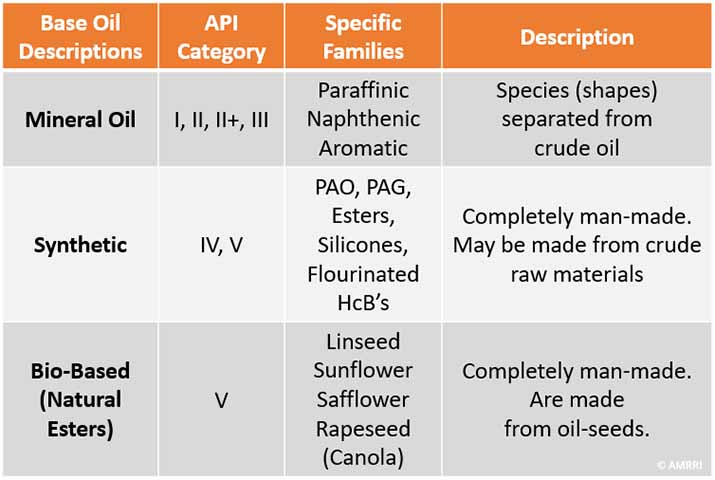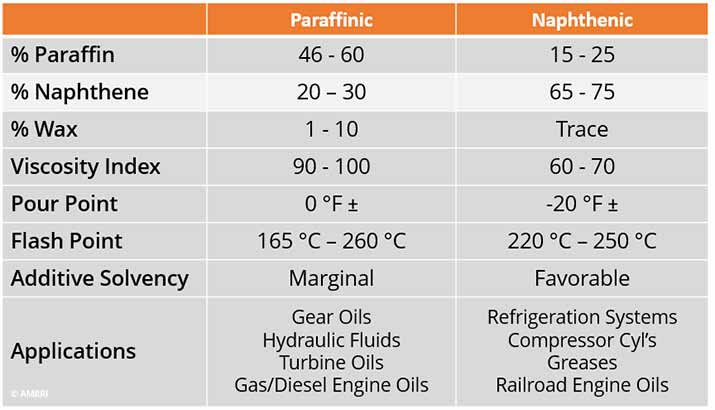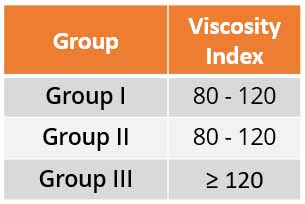What are Base Oils?
Base oils are the starting material for producing lubricants, and their properties greatly influence the performance and characteristics of the finished lubricant. They are typically derived from crude oil but can also be made from synthetic or bio-based sources. The American Petroleum Institute classifies them into five base oil groups.
Base oils define the inherent properties of the finished product, including viscosity, stability/longevity, and load-bearing capacity (the ability to withstand extreme pressures).
For example, a lubricant made with a high-quality, highly refined base oil may have better thermal and oxidative stability than a lubricant made with a lower-quality base oil but NOT have the same degree of load-bearing capacity as a result of the molecular structure and purity.
As a result, the choice of base oil is an essential consideration in producing lubricants. Consequently, selection requires careful thinking and planning around the machine’s operating conditions to produce a finished product that serves the long-term performance interests of the machine owner.
Base Oil Categories
The three general categories of base oils are mineral, synthetic, and bio-based. Beyond these categories, there are well-defined and accepted technical categories that lubricant manufacturers use to select base oils.

Mineral
Mineral base oils are derived from crude oil and are the most commonly used type. They are relatively inexpensive and widely available but also have some limitations, such as a relatively low viscosity index and poor thermal stability.
Mineral base oils are classified according to their refining process and viscosity, such as paraffinic, naphthenic, or aromatic.
Synthetic
Synthetic base oils are man-made and can be tailored to have specific properties, such as a high viscosity index or superior thermal stability. They are typically more expensive than mineral, but they can improve machine performance in many applications.
Synthetic base oils are classified according to their chemical structure, such as PAOs (polyalpha olefin), PAGs (poly alkaline glycol), or esters (diester, polyol ester, phosphate ester, etc.).
Bio-based
Bio-based are derived from renewable sources like vegetable oils or animal fats. They may have similar properties to mineral base oils but are more biodegradable and environmentally friendly.
Bio-based base oils are typically classified according to their feedstock, such as vegetable oil-based or animal fat-based. Like synthetic base stocks, bio-based materials are considered entirely man-made (synthesized) and are expected to demand a higher price.
Advantages and Disadvantages
The advantages and disadvantages of each base oil type depend on the lubricant’s specific application and performance requirements. Mineral oils have the advantage of being widely available and less expensive, but they might have limited performance in particular applications.
Synthetics have the advantage of being tailored to have specific properties, but they may be less compatible with certain additives or seal materials.
Bio-based have the advantage of being environmentally friendly and biodegradable, but are more expensive (than mineral oils) and have somewhat limited availability.
The fundamental base oil properties important in producing lubricants include viscosity, viscosity index, pour point, flash point, and thermal stability. These properties determine how well it will maintain its flow characteristics at different temperatures, how well it will resist oxidation and breakdown, and how well it will protect against wear and friction.
The specific properties of each type will vary depending on its source and refining process.
Base Oil Production and Refining
The process of extracting base oils from crude oil involves several steps, including crude oil selection and preparation, distillation, and refining.
First, the crude oil is selected and prepared for refining by removing impurities such as water, sediment, and other contaminants. The crude oil is then heated and distilled to separate into different fractions based on their boiling point. The lighter fractions are used to make gasoline and other fuels, and the heavier fractions are used to make base oils.
The heavy fractions of crude oil used to make base oils are called lubricating oil stocks, and they typically have a high viscosity and a complex chemical structure. These lubricating oil stocks are then refined to produce finished base oils. The refining process may involve several steps, such as solvent refining, hydrocracking, or iso-dewaxing, to remove impurities, improve the chemical structure, and improve the performance properties of the base oil.
After refining, the base stocks are packaged and shipped to lubricant blenders (manufacturers), where base stocks are mixed with additive blends to produce finished lubricants.
The refining process and the additives used can vary depending on the type of base oil and the desired properties of the finished lubricant.
Base Oil Groups
A classification system from the American Petroleum Institute (API) categorizes lubricating oils according to their production process and performance characteristics. This rating system enables lubricant producers and users to communicate easily about the inherent performance differences that exist due to the makeup of each base oil category. There are five main groups, numbered from one to five.
Group I
Group I base oils are mineral oils derived from petroleum crude and prepared through solvent refining and hydrofinishing. They are the least refined option and contain the most significant degree of variability in the molecule (hydrocarbon) shapes and sizes.
Due to the variability, these base oils are prone to shorter lifecycles (due to the presence of benzene ring structures that are prone to decay). Still, they are also oddly capable enough of providing the highest load support (due to the presence of naphthene ring structures).
Also, due to the molecular variability, Grade I stocks have the broadest range of viscosities from which the blender can select to produce finished lubricants.
Accordingly, Group I oils represent a strange combination of potentially short lifecycles (durability) and superior load-bearing support. Because they are the least refined, they USED to be the least expensive.
With a market shift in production of the last 20 years to higher durability Group II and III stocks, the nature of supply and demand has created conditions where the Group I stocks will price at and above their hypothetically higher quality counterparts.
Group II
Group II are also mineral oil-based materials derived from crude oil. They are produced through a refining process known as hydrocracking, which involves breaking down the larger, more complex molecules (naphthene and benzene ring structures) into smaller, simpler, more uniform molecules. This process results in a purer base oil with improved durability characteristics compared to Group I. Group II are commonly used in the production of engine, hydraulic, turbine, compressor oils, and other lubricants for machines that benefit from a higher level of performance and purity.
They are also generally more expensive than group I. As the hydrocracker breaks molecules into smaller and more uniformly shaped molecules, the viscosity range shrinks toward the low to medium range.
Group III
Group III base oils are also mineral oil-based materials derived from crude oil. Group III materials are also produced through hydrocracking, similar to the method used to make group II oils.
However, group III undergo an additional step called hydro-isomerization, which further rearranges the molecules into an even more uniform and stable structure. This results in a purer base oil with even better durability and temperature response characteristics compared to Group I or Group II.
Group III oils are commonly used to produce lubricants operating under high temperatures where longevity is a particular interest, such as compressor and gas turbine oil, engine oils, and transmission fluids.
Group IV
Group IV are completely synthesized (man-made) oils that begin with an extract from petroleum crude: ethylene or C2H4. They are produced through a chemical process that involves the creation of new molecules rather than refining existing ones. This results in a molecule shaped like a branched paraffin, but it is too pure, uniform, and highly organized to be called a branched paraffin.
Group IV base oils are commonly used to produce high-performance lubricants, such as motor oils and transmission fluids. The specific name for Group 4 base stocks is PolyalphaOlefins. They are also referred to commercially as SHC, an abbreviation for Synthetic HydroCarbon.
Group V
Group V base oils include all that do not fit into any other groups. It is a catch-all category that encompasses a wide variety of base oils, including synthetic lubricants, bio-based oils, and any other type of oil that does not fall into one of the first four groups.
Group V can have a wide range of properties and performance characteristics, depending on their specific composition and production process. They are commonly used in various applications, from automotive to industrial lubricants. Like group IV, group V oils can be expensive, depending on the specific type of oil and its intended use.
Some other examples of group V, include esters, poly-glycols, silicone oils, perfluoropolyethers (PFPEs), and other specialty oils used in specific applications.
Base Oil Applications
Base oils are used as lubricants in many industries and applications, including automotive, aviation, industrial, and many others. Base stocks represent 90% to 99% of a finished industrial lubricant and 70% to 90% of finished automotive engine and transmission oils.
In the industrial sector, base oils are used as lubricants in various applications, such as gear oils, compressor and turbine oils, hydraulic fluids, and greases. They are chosen based on the equipment’s specific performance requirements and operating conditions, such as the temperature, load, and speed, to provide the necessary lubrication and protection.

In the automotive industry, which includes construction, rail, and mining machinery, base oils are used as lubricants in various applications, such as motor oil, transmission fluid, gear and hydraulic oils, and brake fluid.
They are chosen based on their performance characteristics, such as their viscosity, thermal stability, and wear protection, to provide the necessary lubrication and protection for the various components of a vehicle or machine.
In the aviation industry, base oils are used as lubricants in aircraft engines, hydraulic systems, and other applications. They are chosen for their ability to withstand the high and low temperatures, pressures, and loads encountered in aviation applications.
Base oils are also used as lubricants in many other applications, such as marine and agriculture.
Emerging and Specialized Applications
In addition to the traditional industries and applications, emerging and specialized applications are starting to use base oils or are developing new ones to meet their specific needs.
One emerging application is in the field of electric vehicles (EVs). As EVs become more popular, there is a growing need for lubricants that can meet the specific performance requirements and operating conditions of EV components, such as electric motors and battery systems.
This has led to the development of specialized base oils and lubricants for EVs, with improved thermal stability, low toxicity, and compatibility with EV components.
Another specialized application is in the field of medical devices. Medical devices, such as implantable and medical instruments, require lubricants that can meet strict requirements for biocompatibility, sterility, and performance.
These requirements call for specialized base oils and lubricants for medical applications, with improved biocompatibility and performance in sterilization processes.
The need for improved performance, biocompatibility, and environmental performance in various industries and applications drives base oil’s emerging and specialized applications.
The industry will evolve and innovate to meet the changing needs of its customers as new technologies and applications develop.
Physical Properties
Several physical properties are used to characterize base oils. Some of the most important physical properties include the following:
- Viscosity: A measure of a fluid’s resistance to flow. Oils with a higher viscosity will have a thicker consistency and flow more slowly than those with a lower viscosity.
- Viscosity index: A measure of the change in viscosity of a base oil with temperature. A base oil with a high viscosity index will have a relatively stable viscosity over a wide range of temperatures.

- Pour point: The lowest temperature at which a base oil will flow. Oils with a low pour point are preferred for cold weather conditions.
- Flash point: The temperature at which a base oil gives off sufficient vapor to ignite in the presence of an ignition source. Oils with a high flash point are less likely to ignite or cause a fire.
- Clarity: Refers to the transparency or clarity of the base oil when it is in a liquid state. A clear oil will be transparent and free of any suspended particles or impurities that could affect its performance.
- Volatility: Refers to the extent of fluid displaced (turns to vapor) when exposed to high temperatures. A base stock’s volatility is a crucial performance indicator for its usefulness in high-temperature applications like combustion engines.
Other physical properties include density, refractive index, and surface tension.
History of Base Oils
The use of oils as lubricants dates back to ancient times when people used animal fats and vegetable oils to reduce friction and wear in mechanical devices such as chariots and water mills. With the birth and growth of the industrial era, mineral oils have been extracted from crude oil and used as lubricants, providing improved performance and stability compared to animal-based oils.
The modern base oil industry began to develop in the early 20th century, with refining processes that could produce high-quality base oils from crude oil.
Over time, the technology has continued to evolve, with the development of synthetic and bio-based oils and new refining processes that can produce them with improved properties.
Today, the base oil industry is global, with companies producing base oils in many different countries and supplying them to lubricant manufacturers worldwide.
The industry is highly competitive, with companies constantly seeking ways to improve the quality and performance of their base oils and reduce the environmental impact of their production.
Here are some key milestones and innovations in the history of base oils:
- 1859: The first commercial oil well is drilled in Pennsylvania, USA, ushering in the era of petroleum-based lubricants.
- 1868: The first lubricating oil patent is granted in the USA for an oil made from sperm whale oil and tallow.
- 1869: The first lubricating oil refinery is built in Cleveland, Ohio, USA, to produce kerosene and lubricating oil from crude oil.
- 1902: The first hydrocracking process is developed, allowing for the production of high-quality base oils from crude oil.
- 1920s: The first solvent refining processes were developed, allowing for the production of highly refined base oils with improved properties.
- 1940s: Synthetic base oils are developed, including polyalphaolefins (PAOs) and polyalkylene glycols (PAGs).
- 1990s: Bio-based base oils are developed from renewable sources such as animal fats and vegetable oils.
- 2010s: New refining processes are developed to produce base oils with improved environmental performance, such as hydroisomerization and isodewaxing.
The importance of base oils in lubricant production and various industries cannot be overstated. They provide the foundation for lubricants, and the performance and their properties significantly affect the performance and characteristics of the finished lubricant.
As a result, the base oil industry is a critical part of the global economy. Continued evolution and innovation will play a vital role in developing new technologies and applications in many industries.









